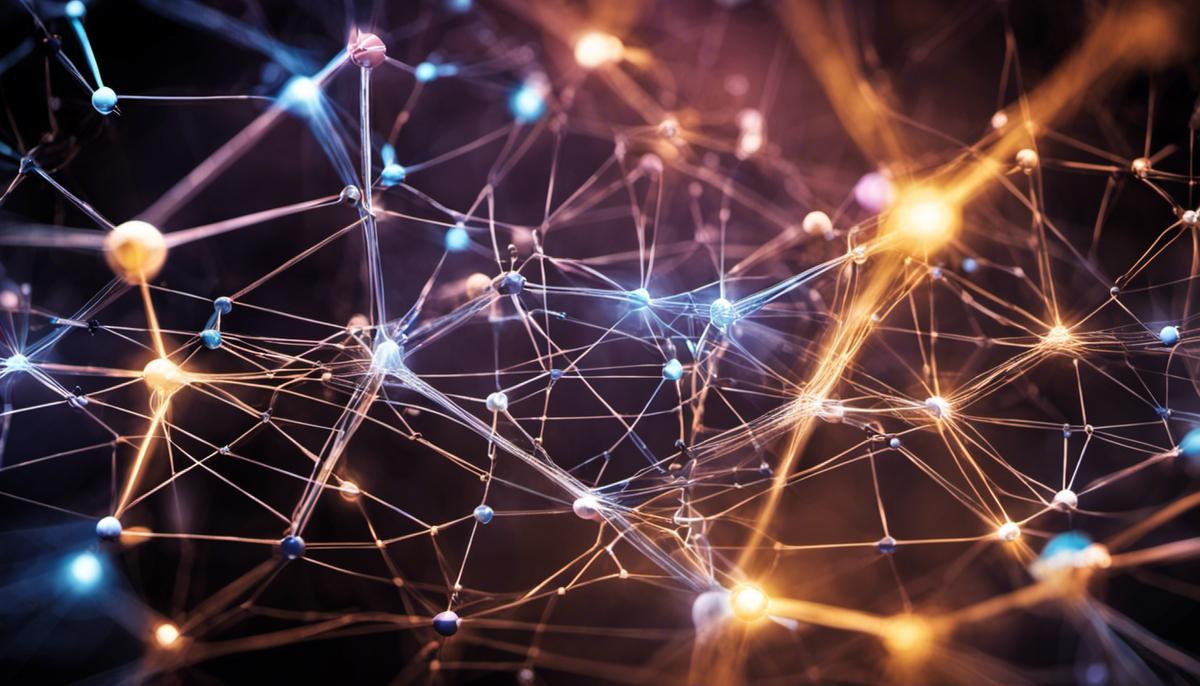The emergence of quantum networking marks a pivotal change, introducing a new dynamic of strength and efficiency in data transactions. This revolutionary technology, built on the principles of quantum superposition and entanglement, diverges significantly from classical networking, offering enhanced security coupled with ultra-efficient information exchange. The fundamental understanding of Quantum Key Distribution (QKD) further underscores the robust security infrastructure of quantum networks, highlighting the efficiency and encoded integrity of this cryptographic approach. Despite promising unparalleled security, quantum networks aren’t invincible, as potential threats such as quantum hacking and decoherence loom on the horizon. However, with continuous advancements and rigorous research underway, the future of quantum network security looks robust and resilient.
The Essence of Quantum Networking
The Underlying Principles of Quantum Networks: An In-Depth Exploration
The world’s scientific fraternity stands on the cusp of a revolutionary movement, tracing the monumental leaps of Quantum Networking. A veritable bridge between the microscopic quantum world and our macroscopic everyday life, Quantum Networking holds extraordinary promises for our future in quantum computing, cryptography, and communication. In deciphering its nuanced functioning, one ventures into the mesmerizing realms of quantum mechanics. To fully grasp the principles that govern the functioning of quantum networks, the fundamental concepts of Quantum Entanglement and Superposition need exploration, with a dash of Quantum Encryption for wholesome understanding.
Quantum Entanglement, a cornerstone of quantum mechanics, is pivotal to the functioning of quantum networks. It is a distinctly quantum phenomenon where two or more particles become intricately linked and instantaneously affect each other regardless of the separating distance. This inseparable bond enables Quantum Networking to provide instantaneous communication, overcoming the spatial constraints of classical communication systems.
Superposition, another gem of quantum mechanics, further distinguishes quantum networks. A quantum system can exist in multiple states simultaneously until observed or measured. Quantum bits (qubits) harness this principle, unlike classical bits that exist in either 0 or 1 state. Qubits can exist as both 0 and 1 at the same time, massively amplifying computational power and data transmission rates. The principle of superposition fuels the phenomenal speed and parallelism associated with quantum networks.
Utilizing these underlying quantum mechanical phenomena, quantum networks exhibit enhanced security protocols. Quantum Encryption, or quantum key distribution (QKD), exploits the peculiar behavior of quantum particles, ensuring secure data transmission. Any attempt to eavesdrop on a quantum communication is detected as it invariably disrupts the quantum state of the system. Thereby, Quantum Networking provides a virtually unhackable communication system, a potential boon in this cyber-attack-prone age.
As quantum mechanics bends the familiar classical rules, it’s pivotal to appreciate its enigmatic yet lawful universe. Bridging the chasm between theoretical quantum physics and applicable quantum technology, Quantum Networking reaffirms Feynman’s declaration, “Nature isn’t classical, dammit, and if you want to make a simulation of nature, you’d better make it quantum mechanical.”
Therefore, Quantum Networking, governed by these distinguished principles and mysteries of quantum mechanics, seamlessly blends speed, security, and computational prowess, opening new vistas in science and technology. The promise it holds heralds an era where scientific advancements, driven by Quantum Networking, bring a paradigm shift in our perception and interaction with the ever-evolving digital universe.

Quantum Key Distribution (QKD)
Continuing the exploration into the realm of Quantum Networking, one has to mention the vital contribution of Quantum Key Distribution (QKD) towards the enhancement of security in this revolutionary field. A discussion on this cutting-edge technology would be utterly incomplete without appreciating the groundbreaking possibilities it incites, especially in assuring secure communication.
Quantum Key Distribution, in its core, leverages the very properties of quantum mechanics that make it so distinguishable. It utilizes the concepts of superposition and quantum entanglement to create cryptographic keys; these keys are essentially random sequences of bits that allow the sender and recipient to encrypt and decrypt messages securely. But unlike traditional cryptographic methods, QKD possesses capabilities that make it virtually unbreakable, taking security in quantum networking to a whole new level.
One should delve deeper into this to comprehend why QKD is paramount to the notion of impenetrable security in quantum networks. Traditionally, encryption keys could bear the risk of being intercepted or copied en route. But quantum mechanics posits that the mere act of observation changes the state of a quantum particle. In the context of QKD, this means that any attempt at eavesdropping would inevitably disturb the quantum states, altering the key and signaling the presence of an intruder.
The ingenuity behind QKD is that it forces would-be eavesdroppers into a conjectural limbo. Any intervention, no matter how subtle, is rendered detrimental to their purpose while simultaneously alerting the communicating parties. This ability exponentially increases security in quantum networking, making data transmission remarkably tamper-proof. It is an enhancement that classical cryptography can only aspire to reach.
Further enhancing the robustness of QKD is the no-cloning theorem in quantum mechanics. This principle states it’s impossible to create an identical copy of an unknown quantum state. Therefore, any nefarious entity seeking to replicate the quantum key would inevitably fail. This additional layer of unparalleled security is unique to quantum networking, possible only due to the profound and fascinating mysteries of quantum mechanics.
Moreover, the very preparatory workflow of QKD is meticulous and intricate, designed to maintain a high degree of secrecy. Current QKD protocols, such as BB84, place emphasis on creating an environment where keys are securely transmitted, and any key found to be compromised in the slightest degree is promptly discarded.
To conclude, Quantum Key Distribution plays a pivotal role in enhancing the infrastructure and security of quantum networking, making it an idyllic realm of irreproachable data transmission. It is the embodiment of how quantum mechanics can push the boundaries of conventional protocols, offering game-changing impacts and possibilities on communication, data transmission, and cybersecurity.

Potential Threats in Quantum Networks
Just as the quantum universe unravels unique and remarkable capabilities, it echoes potential vulnerabilities that we should consider in the realm of high-security quantum networks. These cryptographic vulnerabilities are an integral part of pushing the boundaries of quantum mechanics, requiring scholars to devote an equivalent measure of their efforts in entangling the security threats presented.
A substantial area of concern lies in the ever-looming threat of quantum hacking. A hacker might potentially decipher the quantum key distribution, despite its perceived invulnerability. Intruders can employ quantum impersonation strategies targeting imperfections in the real-world implementation of quantum input and measurement devices. By tampering with quantum states, intruders might circumvent the security offered by QKD.
Moreover, scholars have outlined potential ‘side-channel attacks.’ These attacks exploit security vulnerabilities presented by seemingly secure quantum networks. They are not direct attacks on the ‘unhackable’ QKD system itself but rather focus on the peripheral devices that QKD systems are connected to. The very detectors that measure quantum signals in QKD systems could be subverted and exploited to divulge vital information thereby enabling interception and manipulation of message transmissions.
Another vulnerability arises from the potential implementation of the emerging quantum computing technology. Once quantum computing realizes its full potential, it can disarm the quantum encryption techniques to violate the presiding security reign of the QKD. Quantum computing’s extensive computational power could decipher quantum encryption, unraveling the security offered by QKD.
Preserving the security aspects of quantum networks also faces challenges due to the resource-intensive nature of QKD systems. Infrastructure upgrades, demanding quantum repeaters for long-range quantum communication, and expanding the QKD networks while ensuring the absence of any ‘information leakage’ present a challenging hurdle in the universal adoption of quantum networking.
Nonetheless, efforts are continuously being undertaken to countermeasure these potential challenges. Countermeasures against side-channel attacks like device-independent QKD, application of quantum random number generators to improve unpredictability and ongoing research for quantum computing-resistant cryptographic algorithms are evolving in tandem with the quantum advancements.
A noteworthy mention is to be made of the Quantum Internet, creating a complex grid of entangled quantum states. This intermingled existence, while ushering in a new era of secure communication, will inevitably open itself up to vulnerabilities yet unknown.
In conclusion, while the high-security realm of quantum networks offers a transformative advantage over classical communication systems, it does not exist without its set of vulnerabilities. As the world pivots towards quantum networking and QKD, comprehensively understanding and developing countermeasures against these vulnerabilities are of pivotal importance. This profound exploration is a testament to the ever-evolving narrative of secure quantum networking – a narrative meticulously etched between the lines of groundbreaking potential and veiled vulnerabilities.

Future of Quantum Network Security
In the evolving landscape of quantum networking, security evolves in parallel, tackling unique challenges and opportunities. One of the swiftly becoming paramount issues in quantum security is quantum hacking. Much like traditional hacking, quantum hacking employs strategies devised to exploit vulnerabilities in quantum systems. The evolving nature of quantum technologies mandates an ongoing examination of these vulnerabilities and implies the need for continual advancements in their countermeasures.
Arguably, the most foundational security mechanism in quantum networking is Quantum Key Distribution (QKD). In the face of potential quantum impersonation strategies, QKD remains steadfast. Endowed with the spectacle of superposition and entanglement, it furnishes cryptographic keys of unparalleled security. However, the flip side is the resource-intensive nature of QKD systems, which necessitates optimization methods and scalable design techniques for practical deployments.
Interestingly, one of the significant challenges to the security of QKD systems is from side-channel attacks. These are not direct attacks on the quantum aspect of the technology. Instead, they target peripheral devices and aspects interconnected to the QKD system. This form of attack could, for instance, exploit vulnerabilities in photon detectors to gain insight into the key. Accordingly, research into hardened countermeasures against side-channel attacks is indispensable and actively ongoing.
Another intriguing endeavor in quantum security is the development of Quantum Random Number Generators (QRNGs). They utilize the inherent randomness in quantum mechanics to produce truly random numbers, playing a significant role in enhancing the security and unpredictability of quantum cryptographic processes.
Looking ahead, with the advent of quantum computing, it is crucial to develop Quantum Computing-resistant cryptographic algorithms. While quantum computers hold the promise of unearthing unprecedented computational capabilities, they also threaten existing security protocols. For encryption methods to remain robust, they need to be resistant to potential decryption attempts by quantum computers.
Finally, a future concept that has sparked numerous fruitful discussions and explorations revolves around the Quantum Internet. This implies a fully-fledged network relying on quantum technologies for communication, bringing forth unknown vulnerabilities in entangled quantum states. This necessitates new methods for network structure, security protocols, and systems.
In conclusion, the roadmap for the evolution and advancement of security in quantum networking is an intricate one, teeming with challenges and opportunities alike. Although a fair share of issues need to be addressed, the unfurling world of quantum secure networking holds much potential to revolutionize our digital future. The future is not just about harnessing the potential of quantum mechanics but safeguarding it as well.

As quantum networking continues to forge ahead, we can anticipate a paradigm shift in the entire landscape of digital communication. The technological progress and investigations being made today carry the potential to enhance or transform our current understanding of network security drastically. Future breakthroughs are likely to tackle existing vulnerabilities and elevate the fortress of security that quantum networks promise. Meanwhile, the critical role of international regulations in setting standards and guidelines will become increasingly pivotal, shaping the potential future of quantum network security. Considering the profound implications and possibilities that quantum networks bring forth, we stand on the brink of a new era, an era that redefines digital security and network communication.
